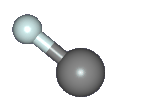Appearance Colourless gas | Formula CH3• | |
 | ||
Related compounds | ||
Methylidyne radical
Methylidyne (also systematically named hydridocarbon(•)), also called carbyne, is an organic compound with the chemical formula CH• (also written as [CH]).
Contents
- Methylidyne radical
- Nomenclature
- Radicality
- Amphotericity
- Fischer Tropsch intermediate
- Preparation
- References
Methylidyne is the simplest carbyne. It is a highly reactive gas, that is quickly destroyed in ordinary conditions but is abundant in the interstellar medium (and was one of the first molecules to be detected there).
In October 2016, astronomers reported that the very basic chemical ingredients of life—the carbon-hydrogen molecule (CH, or methylidyne radical), the carbon-hydrogen positive ion (CH+) and the carbon ion (C+)—are the result, in large part, of ultraviolet light from stars, rather than in other ways, such as the result of turbulent events related to supernovae and young stars, as thought earlier.
Nomenclature
The trivial name carbyne is the preferred IUPAC name. The systematic names methylidyne, and hydridocarbon(•), valid IUPAC names, are constructed according to the substitutive and additive nomenclatures, respectively.
Methylidyne is viewed as methane with three hydrogen atoms removed. By default, this name pays no regard to the radicality of methylidyne. When the radicality is considered, the radical states with one unpaired electron are named methylylidene, whereas the radical excited states with three unpaired electrons are named methanetriyl.
Radicality
All electronic states of methylidyne yield one unpaired electron, giving rise to varying degrees of radical chemistry. The ground state is a doublet radical with one unpaired electron (X2Π), and the first two excited states are a quartet radical with three unpaired electrons (a4Σ−) and a doublet radical with one unpaired electron (A2Δ). With the quartet radical only 71 kJ above the ground state, a sample of methylidyne exists as a mixture of electronic states even at room temperature, giving rise to complex reactions. For example, reactions of the doublet radical with non-radical species involves insertion or addition, whereas reactions of the quartet radical generally involves only abstraction.
[CH]•(X2Π) + H2O → [CHO]• + H
2 or [CH
2(OH)]• [CH]3•(a4Σ−) + H
2O → [CH
2] + [HO]•
Amphotericity
The methylylidyne group (-C•) in carbynes such as methylidyne can accept an electron-pair donating ligand into the molecule by adduction:
[CH]• + L → [CHL]Because of this acceptance of the electron-pair donating ligand, methylidyne has Lewis-acidic character.
The methylylidyne group can also donate an electron-pair to an accepting centre by adduction:
M + [CH]• → [M(CH)]Because of this donation of the electron-pair, methylidyne has Lewis-basic character. An example is HCCo
3(CO)
9. Since a Lewis base is also Brønsted base, methylidyne can in theory be protonated to form a conjugate acid, which is methyliumyl or dihydridocarbon(•+) (CH•+
2).
Fischer-Tropsch intermediate
Methylidyne molecules bound to the catalyst's surface are assumed to occur as intermediates in the Fischer-Tropsch process for conversion of CO to hydrocarbons. A hypothetical sequence is
CO → COH → HC3• → H2C2•The methylene radical H2C2• would then insert itself into an hydrocarbon's backbone, extending it.
Preparation
Methylidine can be prepared from bromoform.
